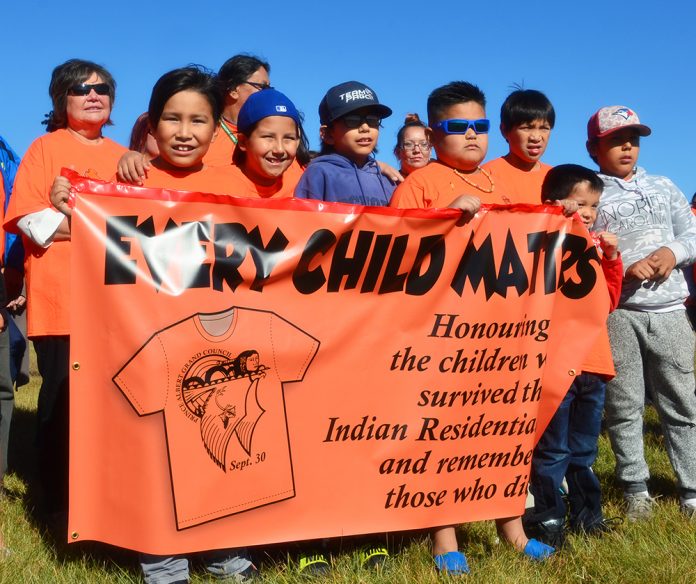
Forty-eight years after he left the Prince Albert Residential School, George Mirasty was back.
“I was here,” he said, “on these very grounds we’re walking.”
Those grounds, now the site of the Chief Joseph Custer Urban Reserve, were once covered with army barracks. That’s where Merasty slept, far away from his family.
“They were hard times,” he said, “missing home, trying to learn a new language and just following the daily routines of residential life.”
Mirasty wants to make sure the people who lived through those times are never forgotten. That’s why he joined other residential school survivors and their young relatives on Friday, to march on the eve of Orange Shirt Day.
It’s an occasion inspired by a young girl who was taken from her family, and stripped of an orange shirt her grandmother gave her. This shirt represents all that was taken from those kids: their culture, their way of life and their innocence.
For Violet Naytowhow, clothing was a symbol of the “regimentation” of residential school life. “We all wore the same type of clothes,” she said, just after finishing the march. She lived at the Prince Albert Residential School just a few years after Merasty left. By then, the barracks were coming down. But the same mentality remained.
“We weren’t allowed to speak Cree, so we would sneak talking to each other out in the playground,” she said.
“I was fluent in Cree when I came,” Naytowhow recalls. “I didn’t talk English – and now I can hardly talk Cree.”
She also remembers the food. It was different from what she ate back home. For the first time, she was confronted with porridge. “It was lumpy and disgusting,” she said. And the meat was nothing like the wild game her family brought home from the trap line.
“You could tell it was canned,” she said. “It didn’t have much taste left to it.”
The people who taught her and cared for her were just as foreign. They couldn’t replace the warmth of a family.
“It’s all strangers,” she said. “They’re not nurturing: no hugging, no encouraging, no raising up your spirit, no one giving you compliments or telling you you’re a good girl. They were very cold and cut off.”
Her brother went to the school too. But she never saw him. The kids were kept separated by gender and age. She never got visitors, and thought about running away.
“It was lonely, very lonely and I often tried to figure out how I could go home,” she said. “If I knew which way it was, I probably would have taken someone and gone.”
Naytowhow said the march around the former residential school grounds is about giving a “voice” to survivors, while respecting and honouring their memory. As she walked around the grounds, she thought about the people she went to school with, wondering if they turned out OK, or if they still live with “their sad memories and their trauma.”
Most of all, she thought about people who didn’t make it through the schools at all. She thought about the hundreds – perhaps thousands – who died, away from their parents, in residential schools across the country. They were the victims of preventable diseases, like tuberculosis, or of fire, of malnutrition, of negligence.
“The ones who didn’t make it through, I thought about that more as I went around,” she said. “I wondered how many didn’t make it across Canada. I know they’re still digging up bodies, bones, in different residential school areas.”
After the march, Naytowhow and Mirasty returned to the Senator Allen Bird Memorial Centre. There, they sat with the next generation, and the generation after that – people who had never known residential schools. The young people learned about the sad history of life at the Prince Albert Residential School.
Eleven-year-old Chaska Omani said facing those memories can be difficult.
“It’s been a long time for the people who went to residential school and it’s been hard for them though the years, remembering about what they experienced when they were kids like us,” he said. “It’s just hard knowing that this happened to them and that these people were our relatives.”
Omani said that he was “feeling their pain” as he walked over the grounds. His own father went to residential school, and came back “lost.”
But he said his dad soon found himself, and Omani is growing up immersed in his people’s traditions. He dances on powwow. Naytowhow, who knows his father, said the boy “knows his culture.”
He’s a symbol of “the resilience, the strength and the power,” that Naytowhow sees in her people. After all the efforts to kill her culture, on the very site where a residential school once stood, a drum circle beats on.
“We’re still here,” she said, “throughout it all, the almost 500 years. Even though we went through a great deal we’re still managing to have young boys singing on the drum, learning the songs.”

